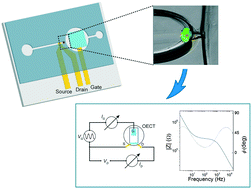A planar impedance sensor for 3D spheroids†
Abstract
Three dimensional cell culture systems have witnessed rapid expansion in the fields of tissue engineering and drug testing owing to their inherent ability to mimic native tissue microenvironments. High throughput technologies have also facilitated rapid and reproducible generation of spheroids and subsequently their use as in vitro tissue models in drug screening platforms. However, drug screening technologies are in need of monitoring platforms to study these 3D culture models. In this work we present a novel platform to measure the electrical impedance of 3D spheroids, through the use of a planar organic electrochemical transistor (OECT) and a novel circular-shaped microtrap. A new strategy was generated to overcome incompatibility of the integration of polydimethylsiloxane (PDMS) microdevices with OECT fabrication. The impedance platform for 3D spheroids was tested by using spheroids formed from mono-cultures of fibroblast and epithelial cells, as well as co-culture of the two cell types. We validated the platform by showing its ability to measure the spheroid resistance (Rsph) of the 3D spheroids and differences in Rsph were found to be related to the ion permeability of the spheroid. Additionally, we showed the potential use of the platform for the on-line Rsph monitoring when a co-culture spheroid was exposed to a porogenic agent affecting the integrity of the cell membrane.



 Please wait while we load your content...
Please wait while we load your content...